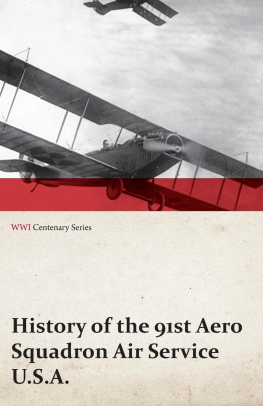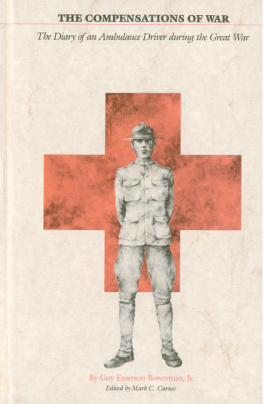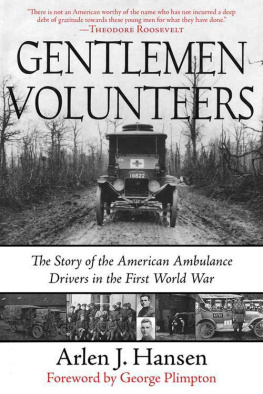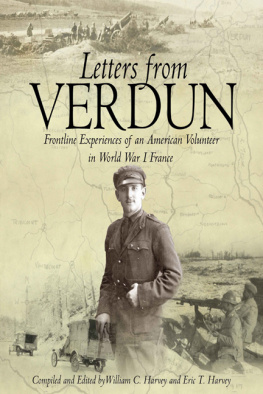
This edition is published by PICKLE PARTNERS PUBLISHING www.picklepartnerspublishing.com
To join our mailing list for new titles or for issues with our books
Or on Facebook
Text originally published in 1917 under the same title.
Pickle Partners Publishing 2013, all rights reserved. No part of this publication may be reproduced, stored in a retrieval system or transmitted by any means, electrical, mechanical or otherwise without the written permission of the copyright holder.
Publishers Note
Although in most cases we have retained the Authors original spelling and grammar to authentically reproduce the work of the Author and the original intent of such material, some additional notes and clarifications have been added for the modern readers benefit.
We have also made every effort to include all maps and illustrations of the original edition the limitations of formatting do not allow of including larger maps, we will upload as many of these maps as possible.
DIARY of SECTION VIII
AMERICAN AMBULANCE FIELD SERVICE
PRINTED ONLY FOR PRIVATE DISTRIBUTION
1917
TABLE OF CONTENTS
Contents
TABLE OF CONTENTS 2
EDITOR'S NOTE
The human interest of this record sufficiently justifies publication, but it is printed primarily because its story is typical of the day's work of every Section in the Field Service, and in order that those Americans who have given ambulances and such practical encouragement may better realize how much their coperation has actually accomplished.
There are now nine of these Sections attached to the Armies of France at various points along the Western Front from the Channel to Alsace, and in Salonika. During the, next few weeks six more are being equipped and sent out. Of the men immediately going over to drive these new cars Chicago University is sending two units of twenty-five men each, and the Universities of Leland Stanford, Harvard, Wisconsin, and California are each contributing a like unit. More than sixty other American colleges and universities are already represented.
While all these men quite realize that their work is but a matter of duty to the cause and nation they wish to serve, the mere fact of their presence and voluntary sharing of the risk and labor involved has done much to convince France of the feeling that really exists for her in this country.
However great the help which new circumstances might make it possible for us to render the Allies by men and money, we can never offer any truer evidence of sympathy than by the service of which these pages bear tribute.
H. D. S.
BOSTON, MASSACHUSETTS
February, 1917
MEMBERS OF SECTION VIII (At time of writing)
CITATION OF SECTION VIII
EXTRAIT D'ORDRE No 80
En excution des prescriptions rglementaires, le Directeur du Service de Sant du 6e Corps d'Arme, cite l'Ordre du Service de Sant du 6e Corps d'Arme
LA SECTION SANITAIRE AUTOMOBILE AMRICAINE No 8
pour le motif suivant:
SOUS la direction du Lieutenant Paroissien, Robert Charles, et du Commandant Adjoint Amricaine Mason, Austin Blake, la Section Sanitaire Amricaine No 8, compose entirement de volontaires, a assur remarquablement le service quotidien des vacuations en allant chercher le plus loin possible les blesss, malgr un bombardement, parfois violent.
S'est particulirement distingue le 23 juin, en traversant plusieurs reprises la nappe de gaz toxiques sous un feu intense sans aucun rpit pendant plusieurs heures pour emmener au plus vite aux ambulances les intoxiqus.
Q. G. le 4 Aot 1916
P. O. le Directeur du Service de Sant
Translation EXTRACT FROM ORDER NO. 80
In carrying out the prescribed regulations the Director of the Sanitary Service of the 6th Army Corps mentions in the orders of the day of that service
THE AMERICAN AUTOMOBILE. SANITARY SECTION No. 8, for the reason following:
Under the direction of Lieutenant Robert Charles Paroissien and of the American Deputy-Commandant Austin Blake Mason, the American Sanitary Section No. 8, composed entirely of volunteers, has been wonderfully efficient in the daily service of removing the wounded, going very long distances to fetch them, despite a bombardment sometimes of great intensity.
It especially distinguished itself on June 23, by passing through the sheet of poisonous gas again and again, without respite, under a sustained fire, for many hours, bringing the men prostrated by the gas to the ambulances as speedily as possible.
Headquarters, 4 August, 1916
P. P. The Director of the Sanitary Service
DIARY OF SECTION VIII AMERICAN AMBULANCE FIELD SERVICE
Mourmelon le Grand, Monday, May 29.
This is to be the diary of Field Section No. 8 of the American Ambulance, sent to the front from Paris in the summer of 1916, and begun this day at Field Headquarters, where we have become a part of the Sixth Army Corps of the Twelfth Division of the Fourth Army. We are quartered nine kilometres behind the front (between five and six miles), and the click of the typewriter is accompanied by the steady booming of distant guns.
But there is a preface that must claim place before we tell of our arrival here, or even of our convoy journey through the Valley of the Marnea preface written in Paris on wood and steel, with hammer, chisel, and file by the members of the section, laboring for days side by side with French mechanics and carpenters in the great shops of Kellner et Ses Fils, building and equipping the ambulance bodies and helping mount them on Ford chassisa labor of love which went with whirlwind speed, for we were building our own cars, and we knew that each screw driven home to its socket by blistered but willing hands meant that we were that much nearer the day of our departure for the front.
Non palma sine pulvere was a proverb that applied, in Roman days, to war as well as to Olympic games, and Pas de gloire sans graisse would make an even more appropriate motto for our section. We came expecting to don steel helmets, and were handed greasy overalls. We accepted the overalls willingly, and now we have the helmets, but let us tell of the overalls first.
It was about the first of May that our section assembled at Paris in the general headquarters of the American Ambulance Hospital in the suburb of Neuilly-sur-Seine. The men were ready, but the cars. were not. The chassis were standing in line in Kellner's great Carrosserie works, near Sevres, a couple of miles beyond the Bois de Boulogne, awaiting the construction of the wooden bodies which were only half completed. Kellner was short of men and we went to Kellner's. Within twenty-four hours men among us who had never swung anything heavier than a mashie were working at forge and anvil, making heavy iron braces and hinges; others drilled holes in the wood and iron; still others screwed and riveted the parts together. The sturdy women who were working by the hundreds in the place of men who had gone to the front stopped building bomb cases and handling heavy tools to watch us for an instant from time to time and bring us little sprigs of lily of the valley, le muget qui porte bonheur!' The French carpenters, who soon learned that we could work as well as they, and faster, became our friends and frequently invited us to share the coarse bread and red wine which they kept loose in the same box with their tools, by way of refreshment between meals.















